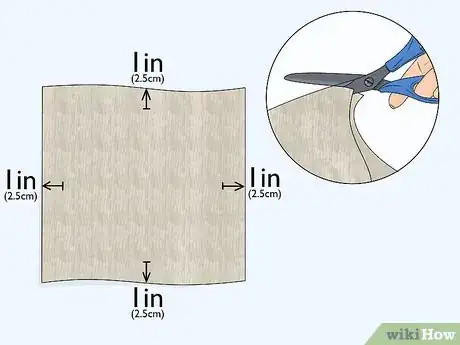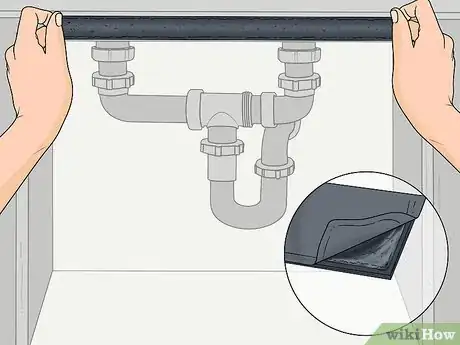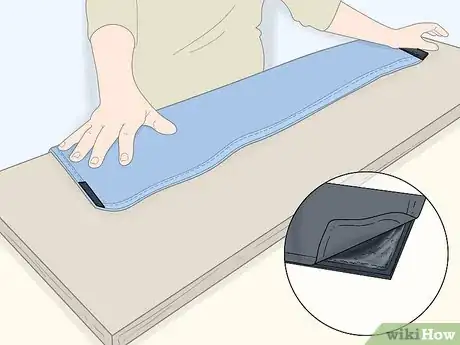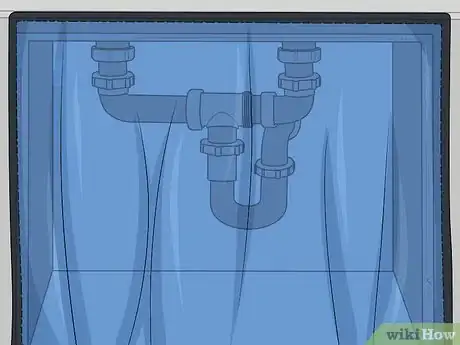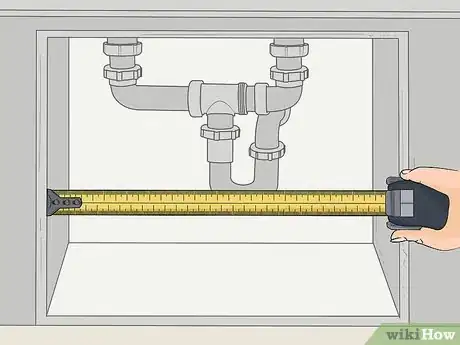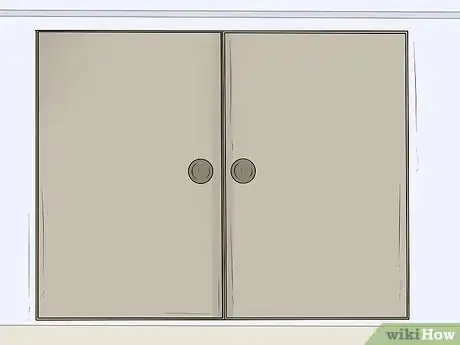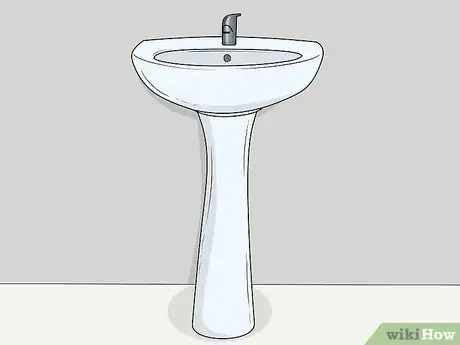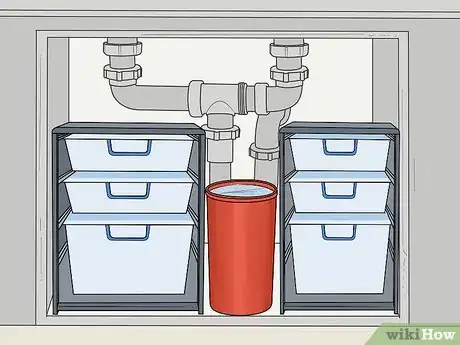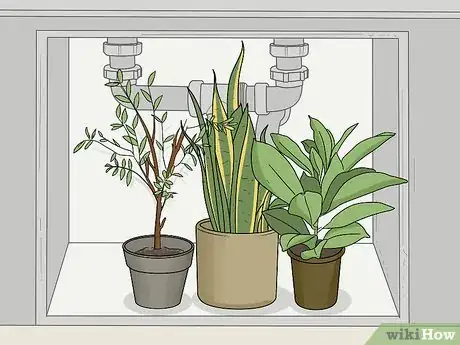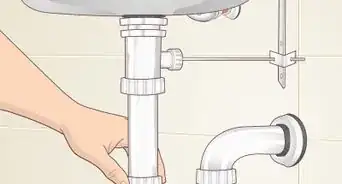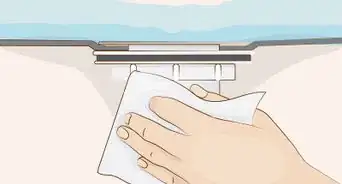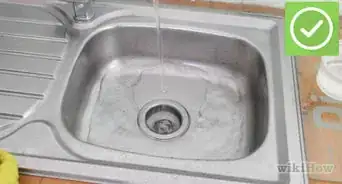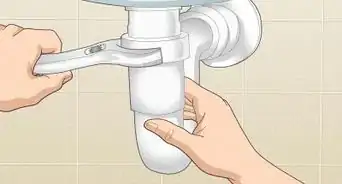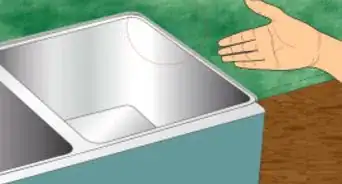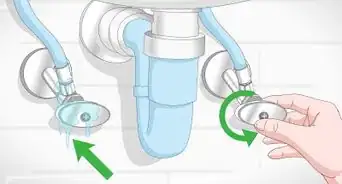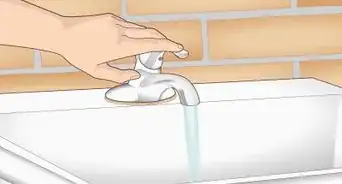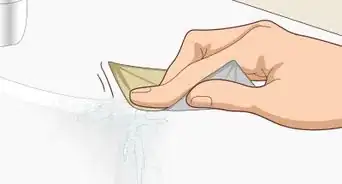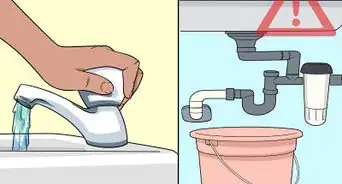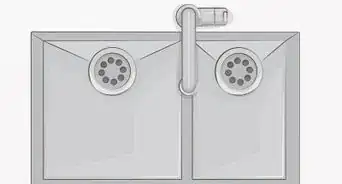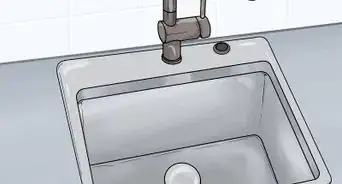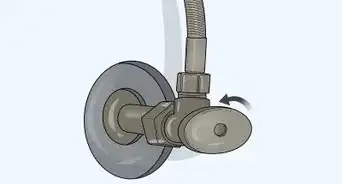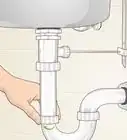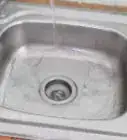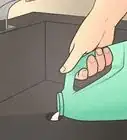This article was co-authored by Patrick Johns and by wikiHow staff writer, Janice Tieperman. Patrick Johns is a Home Improvement Specialist and the Owner of CatchAll Handyman Services. With more than 28 years of experience, he has worked on a variety of home improvement projects, such as carpentry, plumbing, and door and window installations in both commercial and residential properties.
There are 12 references cited in this article, which can be found at the bottom of the page.
This article has been viewed 19,595 times.
While pedestal and utility sinks are a necessity to many households, their exposed pipes can be an eyesore. Although you can’t remove these pipes from the sink, you can completely hide or conceal them in a variety of different ways. If you’re looking for a quick, stylish way to cover your pipes, then you might want to make or purchase your own sink skirt. If you don’t mind putting a bit more time and money into the renovation process, you could arrange new fixtures or cabinets in front of the pipes. Examine your own household’s needs and see what type of solution works best for you!
Steps
Adding a Sink Skirt
-
1Take measurements around and beneath your sink. Use a soft measuring tape to determine the circumference or perimeter of your sink’s bowl. Once you have an exact measurement, write it down so you can remember it later. Next, measure the distance between the lower rim of your sink bowl and the floor. Add this measurement to your notes, so you can figure out how much material you need to cover your sink.[1]
- If you’re measuring a circular sink, hold 1 end of the tape along the left side of the bowl’s rim, then drag it around the curve of the bowl until you reach the right side of the sink. If your sink is especially large, you might want to ask a friend or family member for help.
- If you’re measuring a square or rectangular sink, measure the right, left, front, and back sides of the sink individually (if applicable). Take note of each separate measurement, then add them all together to get an idea of your sink’s perimeter. If you want, you can use a meter stick or metal measuring tape for this.
- A sink skirt is attached beneath the rim of your sink. Depending on the type of sink you have, the location of this rim may vary. For instance, a pedestal sink generally has a curved rim.
- For instance, if your sink is 13 by 17 in (33 by 43 cm), your sink skirt would need to be at least 43 in (110 cm).
Tip: You can buy a sink skirt online for under $10. Some stores list them as “sink curtains.”
-
2Cut out a large section of fabric that fits around your sink. Lay out a piece of fabric that’s at least 1 inch (2.5 cm) larger on each side than the dimensions you just measured. Use a pen and a meter stick or measuring tape to sketch out the full size of your sink skirt along with the 2 in (5.1 cm) of hem allowance. Once the full skirt length plus the extra hem is sketched out, use a pair of fabric scissors to cut out the section of fabric.[2]
- You can find fabric at any store that sells craft supplies. Try to select a thicker material, like canvas or burlap.
- Consider reusing old curtains for this type of project.
- For instance, if your sink is 12 by 15 in (30 by 38 cm), you’d cut out a section of fabric that’s at least 41 in (100 cm).
Advertisement -
3Hem all 4 edges of the fabric to get rid of any coarse edges. Take at least ½ in (cm) of material from the outer edges of the fabric and fold them inward. Use as many pins as you need to secure this folded section of fabric. To hold the hem in place, use a sewing needle or sewing machine to stitch along the folded edge of the hem.[3]
- While you don’t have to hem your material, this process will make your sink skirt look much more sleek and professional.
-
4Stick a length of Velcro along the lower rim of the sink. Cut a long section of Velcro that matches the measurement around the circumference or perimeter of your sink. Remove the adhesive backing, then press the Velcro firmly beneath the rim of your sink. If your sink is especially large or curved, try applying the Velcro in sections. Make sure that the sink has the hooked portion of the Velcro while the skirt has the looped side (or vice versa).[4]
- Follow the instructions that come with your Velcro tape for exact guidance on how to attach the material.
- You can find Velcro tape at any store selling craft supplies.
-
5Cut another piece of Velcro that matches the width of your sink skirt. Lay your sink skirt out on a flat surface so you can attach the Velcro easily. Next, arrange the Velcro along the edge of the upper hem. Check that the Velcro is arranged in a straight line along your fabric so the skirt can fit evenly around the sink.[5]
-
6Sew a line of Velcro on the top edge of your fabric skirt. Pin the length of Velcro in place along the upper hem of your sink skirt to hold it in place. Next, use a needle and thread or a sewing machine to stitch the Velcro strip into place.[6]
- Since your skirt will be heavy, the Velcro needs to be sewn onto the skirt. However, you can use an adhesive Velcro strip along the edge of the sink.
-
7Attach the sink skirt to the lower rim of the sink. Arrange the skirt along the lower rim of your sink so both lines of Velcro line up. Once both sections of Velcro match up, press along the edge of your sink skirt to attach it to the sink. Continue pressing along the entire base of the sink until the fabric is securely attached.[7]
- If you’re using a store-bought Velcro sink skirt, follow the manufacturer’s instructions so you can properly set up the fabric.
Using Alternative Measures to Conceal the Pipes
-
1Measure the open space beneath your sink to get a better idea of your options. Determine the height of your sink by holding a measuring tape in place beneath the lower rim of the sink bowl, then extending the tape downwards until you reach the floor. Next, extend your tape along the back edge of the sink bowl so you can get an idea of how long it is. Additionally, find the width by measuring from the wall to the front rim of the sink.[8]
- These measurements can be useful if you choose to place cabinets, plants, or other items beneath your sink.
- For instance, if your sink is 3 ft (91 cm) long, 4 ft (120 cm) tall, and 2 1⁄2 ft (76 cm) wide, you wouldn’t want to invest in a cabinet that’s 4 ft (120 cm) long, 3 ft (91 cm) high, and 3 ft (91 cm) wide. Instead, look for a cabinet that’s around 2 ft (61 cm) high, 1 1⁄2 ft (46 cm) wide, and 2 ft (61 cm) long.
-
2Install a cupboard or shelf in front of the pipes if you want more storage space.[9] Visit your local home improvement or furniture store to browse through different drawers, cabinets, and shelves. Before making any purchases, check the dimensions of the furniture against the available space beneath your sink. If you don’t want to permanently install a new fixture in your bathroom, look for smaller, portable cabinets or shelves that can be assembled and arranged in front of your sink’s pipes.[10]
- When shopping for cupboards or cabinets, look for items that have an opening or space in the back to store and conceal any sink pipes.
-
3Invest in a bottle trap system to make your pipes look stylish. Visit a home improvement store and browse for a simple fixture to install around your pipes. Choose a bottle trap that matches the color of your pipe, so your sink pipes can look sleek and polished. If you don’t feel comfortable installing this fixture yourself, ask a home improvement professional for help.[11]
- Bottle trap systems tend to be on the expensive side when compared to other pipe concealing options.
-
4Cover the pipes with a pedestal basin if you have a pedestal sink. Check online or in a home improvement store and look for pedestal basins, which are covers designed to conceal the exposed pipes beneath pedestal sinks. Use the measurements of your own sink to compare the pedestal basins to the sink in your own home, and see if you can find a product that meets your needs. If you don’t have a lot of hardware expertise, a professional at your local home improvement store may be able to help you physically install the basin.[12]
- Pedestal basins are typically round sinks that are built into or against the bathroom wall. A basin covers the exposed pipes and serves as the “pedestal” portion of the sink.
- If possible, try to determine the manufacturer of your current sink—that could make it easier to find a basin that fits correctly.
-
5Place a tall basket or storage bin in front of the pipes as a temporary solution. Search around your home for any extra basins, bins, or other portable storage items that you could fit under the sink. If you don’t have anything on hand, visit your local furniture store, or any shop that sells storage bins or baskets. Arrange any tall baskets or storage bins in front of the sink pipes to obscure them from view.
- Depending on the size and curvature of your sink, this might not be a viable option. For instance, a rectangular storage bin probably won’t fit beneath a round, circular sink.
-
6Coat your pipes with paint if you don’t want to add any new fixtures. Set down drop cloths and plastic sheeting around and beneath your sink. To prevent any paint from dripping onto your sink, apply strips of painter’s tape around the base of the sink. Next, dip a wide, 2 to 3 in (5.1 to 7.6 cm) paintbrush into a bucket or painting tray filled with paint designed for metal or PVC pipes. Choose a color that matches the tiling, walls, or some other feature in your room, so your pipes blend in.[13]
- Visit a home improvement or hardware store to find paint that’s safe to use on metal or PVC piping.
- Read the guidelines on your paint can to see how long the paint will take to dry. While you probably won’t bump into the pipes while you use the sink, it’s important to keep in mind in the days and hours after you apply the paint.
-
7Use potted plants to obscure the exposed pipes for a simple solution. Visit a plant nursery to find a large, indoor plant that you can arrange beneath your sink. Specifically, look for something that will fit within the measurements of your sink and block any view of the pipes. If you want extra coverage, purchase an additional plant to arrange beneath your sink.[14]
- A corn plant, olive tree, or croton might be good options to consider.[15]
Tip: Choose plants that can thrive in the humidity and light conditions of your bathroom. For instance, if your bathroom has no windows, don’t select a plant that requires lots of direct sunlight.
Expert Q&A
-
QuestionHow do you hide unsightly bathroom pipes?
 Patrick JohnsPatrick Johns is a Home Improvement Specialist and the Owner of CatchAll Handyman Services. With more than 28 years of experience, he has worked on a variety of home improvement projects, such as carpentry, plumbing, and door and window installations in both commercial and residential properties.
Patrick JohnsPatrick Johns is a Home Improvement Specialist and the Owner of CatchAll Handyman Services. With more than 28 years of experience, he has worked on a variety of home improvement projects, such as carpentry, plumbing, and door and window installations in both commercial and residential properties.
Home Improvement Specialist Install a vanity that covers up your pipes! Just make sure that the shelving and drawers are already cut to fit around your pipes. With a higher quality vanity, all you have to do is get on your knees to see the pipes hidden under there.
Install a vanity that covers up your pipes! Just make sure that the shelving and drawers are already cut to fit around your pipes. With a higher quality vanity, all you have to do is get on your knees to see the pipes hidden under there.
Things You’ll Need
Adding a Sink Skirt
- Soft measuring tape
- Pen
- Fabric (large enough to surround sink)
- Fabric scissors
- Sewing needle
- Thread
- Velcro (self-adhesive)
- Sewing machine (optional)
- Meter stick (optional)
Using Alternative Measures to Conceal the Pipes
- Measuring tape
- Cupboard or shelving system
- Pedestal basin
- Bottle trap
- Basket or storage bin
- Paint
- Paintbrush
- Drop cloths
- Painter’s tape
- Indoor plants
References
- ↑ https://www.bobvila.com/slideshow/20-instant-updates-for-a-laundry-room-you-can-love-49863#skirt-your-sink/#11
- ↑ https://www.youtube.com/watch?v=vY73o_ZCwA4&t=0m46s
- ↑ https://www.bobvila.com/slideshow/20-instant-updates-for-a-laundry-room-you-can-love-49863#skirt-your-sink/#11
- ↑ https://www.youtube.com/watch?v=vY73o_ZCwA4&t=4m15s
- ↑ https://www.youtube.com/watch?v=vY73o_ZCwA4&t=3m40s
- ↑ https://www.youtube.com/watch?v=vY73o_ZCwA4&t=4m15s
- ↑ https://www.bobvila.com/slideshow/10-vintage-decorating-ideas-we-were-wrong-to-abandon-51665#wrought-iron-bed/#11
- ↑ https://www.thisoldhouse.com/ideas/read-you-redo-bath
- ↑ Patrick Johns. Home Improvement Specialist. Expert Interview. 5 April 2022.
- ↑ https://www.theplumbette.com.au/plumbing/5-ways-conceal-waste-pipe-vanity/
- ↑ https://www.theplumbette.com.au/plumbing/5-ways-conceal-waste-pipe-vanity/
- ↑ https://www.youtube.com/watch?v=a_8-zz8tc7U&t=1m49s
- ↑ https://www.bobvila.com/slideshow/10-vintage-decorating-ideas-we-were-wrong-to-abandon-51665#wrought-iron-bed
- ↑ https://worstroom.com/how-to-hide-exposed-pipes/
- ↑ https://www.bobvila.com/slideshow/10-huge-houseplants-that-make-a-statement-52621#croton-large-houseplant

